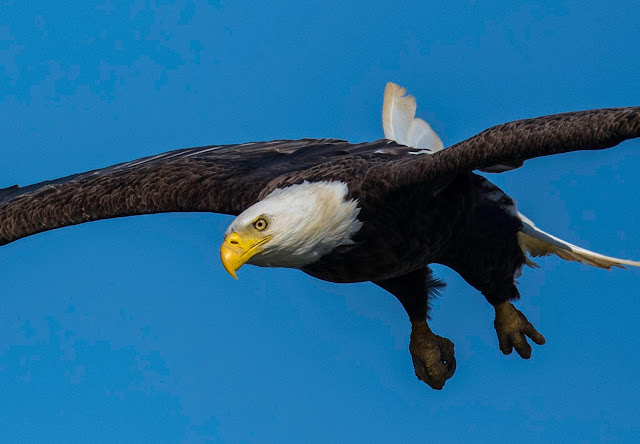One of the great recoveries of the late 20th century is the story of the return of the eagles to the James River. This success not unlike the recovery of all raptors throughout the United States is a tribute to the environmental movement and the work of Rachael Carson. In her book "Silent Spring" published in the 50's. Ms. Carson highlighted the broad use of the pesticide DDT which was used to eliminate insects that were menacing the agricultural industry. DDT created in the late 1800's earned its creator a Nobel Prize for its ability to eradicate insect borne diseases such as yellow-fever and malaria. The unintended consequence of its use identified DDT as a carcinogen. DDT also worked its way up through the food chain from seeds to rodents which resulted in birds of prey laying softened egg shells which broke when they sat on their nests. As a result by the time a ban was placed on DDT in 1972 there were no nesting eagles on the James river and subsequently a reduction of birds of prey throughout the United States. The American Eagle, symbol of our country, was on its way to extinction.
This and many other facts about our eagles were shared by Mike Ostrander who runs an operation called "Discover the James". Having now traveled on two of Mike's excursions I have been impressed by his passion for these birds, knowledge about them and the James estuary which he willingly shares These two hour boat trips which leave from Deep Bottom State Park boat landing are wonderful for photographers, bird watchers and naturalists alike.
During our two hour excursion we passed through the territories of 5 nesting pairs of eagles and numerous ospreys. We learned how eagles protect their territories and raise their young. Eagles have rebounded magnificently in the past forty years and have been removed from the endangered species list.
Bald Eagle chasing and Osprey to take his fish - A familiar eagle tactic!
Most of the eagles on the James are native born birds except one banded bird that has been identified by its tag as a captive-born bird from a refuge in Alabama. Aptly named "Bandit" she has worked her way up to the James River to make a permanent home. Eagles remain in the area through the seasons and build their same nests year after year strengthening them each Spring.
A picture of "Bandit" from last years excursion.
Eagles keep their same nests year after year
In addition to the eagles one can see numerous ospreys who compete for fish in the estuary. Ospreys migrate south for the winter but return to our shores in the early Spring. A photographers prize is to catch a familiar behavior of the Osprey catching a fish ,only to be "body slammed" in mid-air by an eagle, dropping his fish. The eagle then does a swooping loop to retrieve the fish. This photo opportunity, though witnessed on our excursion, evades me still. Capturing birds in flight is a difficult genre of photography which gives great satisfaction when you get it right!
Captain "Mike" sharing his passion for the River with my Grandchildren Liam and Nora
In closing this wonderful story of conservation success, I will share with you a few more images of these majestic birds on the James river - Enjoy






















These pictures are just incredible!! Your pictures always amaze me!
ReplyDeleteAnn Meador